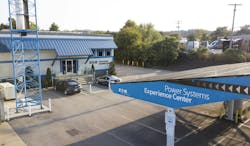Getting EV Charging Infrastructure Projects Off the Ground
Transportation — whether for fleets, public transport, or personal use — is becoming increasingly electric. This electrification will have a cascading impact on energy infrastructure — from the electric grid to homes and buildings.
According to the International Energy Agency, the number of passenger electric vehicles (EVs) on the road will grow by 23% annually from 2023 to 2035, while electrified fleet applications are expected to increase by 27% per year during the same timeframe. That’ll create surging demand for electricity, with electrification efforts in transportation and building systems expected to increase electrical demand by 50% by 2050.
This means both new and existing infrastructure will need to be updated or designed to support EV charging. So, how do you right-size electrical systems for EV charging with the ability to scale and meet this increasing demand?
Intelligence is essential for an electrified future
As energy consumption skyrockets, intelligence from smart electrical devices is a game changer, enabling new insights, control, and access needed to make the most of electrical capacity. For example, merging EV charger technology and smart breaker technology into a single panel offers greater flexibility and scalability for your deployment. With this approach, a single cable and conduit can be run to an EV panel that includes EV smart breakers for today’s needs, while also providing scalable accommodation for future EV adoption.
Similarly, you can run a single section of busway for fleets requiring higher power chargers, supporting the ability to add chargers as you convert your fleet at a pace that suits your business. These smart breaker-based EV chargers provide granular energy data, charge status, connectivity, protection, and control, helping your customers maximize infrastructure efficiency in minimal space.
Additionally, load management features can help you electrify more chargers without overloading the electrical system. These types of software platforms create a virtual twin of the electrical system with EV supply equipment and other loads and automatically manage and adjust the energy available for charging — enabling the fastest possible charge across networked chargers without overloading networks.
A microgrid incorporating renewables and energy storage offers a powerful solution for enhancing resilience and flexibility or to support electrification when the electric utility cannot meet additional power needs. Whether your customer is exceeding their electrical capacity, needs to control energy costs, wants to reduce their carbon footprint, seeks to ensure energy resilience in the face of severe weather, or all of the above, a renewable energy microgrid can help. This flexible approach also enables an energy system to scale over time as demand increases, with clean, affordable energy generated on site.
Don’t overlook interoperability and cybersecurity
As electrical systems become more complex, everything needs to work together. At the same time, electrical systems, including electric vehicle charging infrastructure (EVCI), need to be connected — making cybersecurity a must. It’s important to work with vendors that utilize a secure development life cycle process and comply with third-party cybersecurity criteria for network-connected products and systems to provide confidence that systems will remain cyber-secure throughout their entire lifecycle.
For example, networked EV charging solutions should adhere to open standards (including NACS) and comply with the industry’s Open Charge Point Protocol (OCPP), which is governed by the Open Charge Alliance (OCA) and formally certifies products for compliance. The cybersecurity aspect of OCPP defines an end-to-end security design architecture and implementation guidelines for charging devices and management software.
On the hardware side, cybersecurity should be integrated at every level, including all communication interfaces and controllers. Additionally, the software element of the EV chargers should be continuously monitored for potential vulnerabilities, including malicious firmware, which will not be accepted by the chargers.
EVCI considerations for brownfield projects
Easily and cost-effectively adding chargers to existing infrastructure is crucial. Overall, the system design will hinge on the available capacity, location of the chargers, future needs, and the possibility of adding on-site energy assets to meet growing electrical needs.
That said, for existing brownfield projects, civil engineering, such as concrete work, is often one of the biggest costs to add EVCI. Thus, it’s important to minimize or eliminate the need for trenching in concrete to power EV chargers. Electric panelboards with built-in EV charging smart breakers and overhead busway solutions can help eliminate the need for traditional charging pedestals in some applications, enabling the ability to expand and reconfigure infrastructure if needed with no concrete work required.
Making the most of existing electrical capacity is a critical step. Where a power system study identifies a lack of available capacity to meet anticipated load requirements, battery storage systems can be incorporated.
Using on-site battery storage decreases the need for immediate utility upgrades, helping to expedite projects and storing energy for intelligent charging and demand response. Energy storage can also mitigate costly electric utility peak demand charges, which can account for upward of 70% of a site’s electricity bill if not managed correctly. If renewable sources such as solar are being considered to help fill capacity gaps, on-site battery storage is often also necessary to ensure power availability without electric utility upgrades.
Further, location and physical design should be considered to comply with the Americans with Disabilities Act (ADA). Perform due diligence to ensure the charging system can be used by all and is designed per local building requirements.
Electrical contractors and consultants play a vital role in the design, installation, commissioning, and maintenance of EV charging infrastructure. It’s important to provide this valuable input, especially when it comes to distribution limitations, conduit routing, communications infrastructure, and more.
EVCI considerations for greenfield sites
Many of the design considerations for brownfield projects apply to greenfield projects. The top priority should be on planning for future electricity needs to control construction costs. Size the system to accommodate the electricity requirements today and in the years to come, and create an EV-ready system to avoid costly upgrades/updates later.
At the start of the project, map out and plan for charging infrastructure to optimize power system design. Using a dedicated transformer for EVCI is a best practice that simplifies load management. While this may seem obvious, it is crucial to strategically locate power distribution equipment close to charging stations to enable shorter cable runs and reduce costs/labor. Due diligence during these early stages is critical to avoid extra concrete work in the future if EVCI capacity becomes insufficient. Planning for 50%, 60%, and 80% electrification when you pour your pad will save significant civil work as EV adoption grows. It is important to future-proof the building and ensure compliance with code requirements, which may or may not be adopted in the building’s city or jurisdiction.
You also need to closely evaluate the local electric utility’s capacity to support EV charging and overall energy needs. If the local capacity is limited, a microgrid incorporating DERs can provide the needed power.
More generally, greenfield projects present an opportunity to create solar-plus-storage-ready power systems and connections. Planning now will help simplify, expedite, and reduce the cost of future investments in sustainability and energy resilience.
Seize the opportunity to support the energy transition
It is an incredibly exciting time to be in the electrical industry. As federal stimulus funding propels clean energy and electrical resilience projects, there are once-in-a-generation opportunities to help your customers build a foundation for a low-carbon, electrified future that’s safe, affordable, and resilient.
Today’s electric systems need to do much more than simply receive power from the grid to distribute to building loads and equipment. Designing effective EVCI requires careful planning and a forward-thinking approach to accommodate future growth. Go a step further by leveraging smart technologies, integrating renewable energy sources, and ensuring interoperability and cybersecurity to create a resilient and scalable EV charging network that will meet the demands of today and tomorrow.
Remember that staying informed and adaptable is key. By keeping up with the latest code changes and design best practices, you can play a pivotal role in shaping the sustainable, electrified future of transportation.
A Checklist for EVCI Success
A comprehensive approach to EVCI should integrate charging infrastructure into existing energy infrastructure (EVCI) to minimize the space and labor required while maximizing safety and security. To enable smart, cost-effective, seamless, space-saving deployment and operation while supporting modular and scalable infrastructure, you should ask yourself:
- What does the EVCI need to support and where is it needed? From access control to collecting payments and load management, charging infrastructure typically needs to do a lot more than deliver power.
- How many chargers (and what size chargers) are required to meet your needs today and in the future? Expanding electrical capacity is expensive and time-intensive. Right-sizing your chargers from the offset can help you save on upfront infrastructure costs. While building the charging infrastructure needed today, electrical system design needs to be ready for whatever will come next.
- Which charging configuration is best for the application? Direct connect charging solutions connect directly to a junction box or panelboard using an EV charging smart breaker to eliminate the need for a traditional pedestal and related concrete work. EV charging busway can provide flexible, overhead charging that is ideal for fleet applications. Meanwhile, pedestal and wall-mounted designs offer an intuitive interface to make charging accessible in open parking areas.
- Is there sufficient available electrical capacity? This involves looking at what’s available in the building infrastructure as well as the local electric utility grid constraints. It’s important to note that the 2023 National Electrical Code (NEC) Art. 625 requires EVCI to be considered a continuous load, which means the overcurrent protection should be sized for 125% (at minimum) of the maximum charging load and the power distribution must be sized for 100% of the EVSE load. Using software with a load management feature can help you to right-size your infrastructure and is allowable per the NEC. Understanding which NEC code cycle applies to your jurisdiction will influence your design. It’s important to consult with a specialist to ensure you are compliant.
- Is the local electric utility on board? Specific electric utility requirements for EVCI vary and it’s important to understand and engage with the local electric utility at the beginning of the design process. For example, some electric utilities require a new service and meters for EVCI. If your project requires additional service capacity, it will likely necessitate a utility interconnection study to determine if the existing infrastructure can support the additional load; this process takes time, and working with the local electric utility upfront is essential.
- How will you network chargers? A solid communication backbone is vital to charging system uptime and reliability. Robust network connectivity is necessary for centralized monitoring, access control, collecting payment, and other important functions related to optimizing the EV charging infrastructure.
About the Author

Joe Cappeta
Joe Cappeta, director of technical applications for energy transition at Eaton, has more than 15 years of experience in the electrical industry. He has designed and applied electrical power systems installed globally that integrate distributed energy resources, enable electrification of transport, back up critical data processing equipment, and distribute power to a world that is increasingly electrifying. Joe holds a B.S in Electrical Engineering from the University of Pittsburgh and an MBA from Georgetown University.


